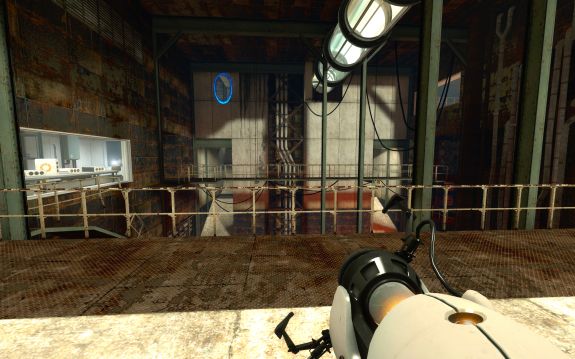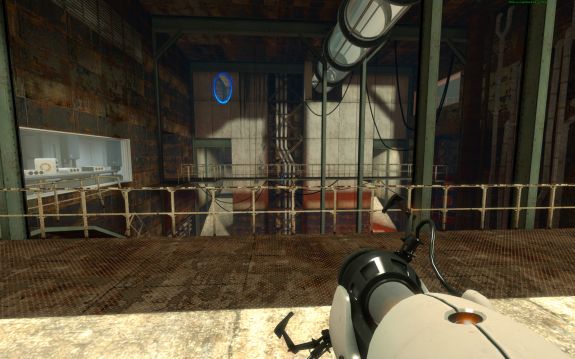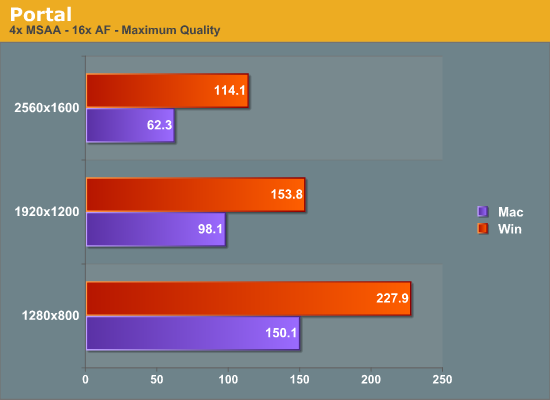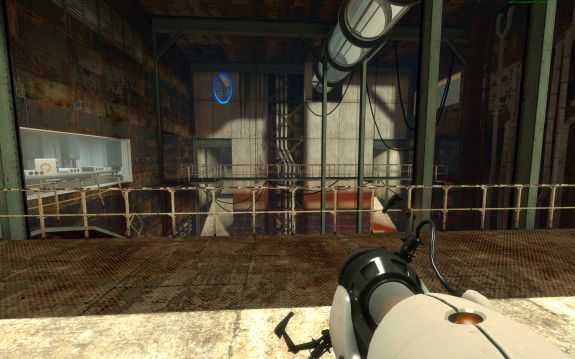Update 5/15/2010: Valve released a new patch for Portal on the 13th which resolved the blurriness issue. Please see our update below for for the full details.
It’s been a while since anyone treated Mac OS X as a first-tier gaming platform, so when Valve announced that they would be bringing their Steam service and the Source engine to the Mac, it was big news. After a roughly 2 month beta period for the Mac versions of Steam and the Source engine, yesterday Valve finally released the first wave of their Mac gaming efforts.
As it stands Valve is taking a gradual approach to rolling out their back catalog to the platform. Even though Steam is out and the Source engine has been ported, this week has seen the release of only 1 Source game for the Mac: 2007’s critically acclaimed Portal.
While it’s not the most graphically intensive Source game these days (that title belonging to Left 4 Dead), at this point it’s as good as anything else for looking at the performance of the Source engine under Mac OS X, particularly considering how long it’s been since a game’s original developer did the Mac port. So with that in mind, we went ahead and took a quick look at Portal’s performance under Mac OS X.
As is the case with all of the games on the Source engine, they’re designed to scale up and down fairly well. With modern hardware though, we’re hard-pressed to keep older Source games from achieving runaway frame rates. So Portal performance is somewhat arbitrary – most Macs with a discrete GPU should be able to handle it to an acceptable degree.
The Test
For our test we loaded up our GPU test rig with Mac OS X 10.6.3 in a Hackintosh configuration. As Mac OS X does not currently support either the GeForce GTX 400 series or the Radeon HD 5000 series, we had to step back a bit with our video card choice, settling for a GeForce GTX 285. And while the use of a Hackintosh does technically invalidate our results since it’s not a real Macintosh, based on our experiments we believe that our results don’t suffer in any way for using a Hackintosh, and as such we believe the results to be experimentally valid. But of course, your mileage may vary.
| CPU: | Intel Core i7-920 @ 3.33GHz |
| Motherboard: | Intel DX58SO (Intel X58) |
| Chipset Drivers: | Intel 9.1.1.1015 (Intel) |
| Hard Disk: | OCZ Summit (120GB) |
| Memory: | Patriot Viper DDR3-1333 3 x 2GB (7-7-7-20) |
| Video Cards: | NVIDIA GeForce GTX 285 |
| Video Drivers: | NVIDIA ForceWare 197.13 |
| OS: |
Windows 7 Ultimate 64-bit Mac OS X 10.6.3 "Snow Leopard" |
Image Quality
We’ll start quickly with a look at image quality. Valve is traditionally a staunch Microsoft ally, having built up their services and engines around Windows and DirectX. For the Mac OS X port of Source, Valve had to replace the DirectX backend of Source with Mac-appropriate components, the key of which is OpenGL. Such a change can impact image quality depending on how it’s done.

Portal - Windows. Click to enlarge

Portal - Mac OS X. Click to enlarge.
We have a gallery of screenshots, but for our analysis we’ll stick with comparing in a single set. Going with 2560x1600 with the game at its highest settings and 4xAA/16xAF, to our surprise the images are distinctly different when directly compared. The Mac screenshot is noticeably foggier than the Windows image, and textures appear to be less sharp. It’s not a night & day difference, but the Windows screenshot is distinctly clearer than the Mac screenshot. Without a Windows reference image it would be harder to tell that the Mac screenshot differs this much, but we believe that the difference is great enough that anyone with an eye for details that has ever played Portal on Windows would notice the foggier/blurrier IQ on the Mac.
Now some of this can be explained away due to gamma, since Mac OS X and Windows have different default gamma levels, but gamma could never explain the entire difference. There’s clearly a difference in IQ between the Windows and Mac OS X versions of Portal, and it’s not in the Mac’s favor. It’s by no means bad, but as one person put this when being shown these screenshots “It’s like looking at a magazine scan” when looking at the Mac.
Performance
The other half of our quick look is at performance. The Macintosh platform is renowned for being a graphical powerhouse, but this refers to professional/prosumer photography and the like. For gaming, Apple has been slow to include support for new hardware and new driver features (they are just now OpenGL 3.0 compliant) and overall their drivers are more conservative when it comes to performance. Portal is going to be slower, the question is by how much.

We went ahead and ran a timedemo from test chamber 18 and beyond on both the Mac OS X and Windows versions of Portal. We kept the settings cranked up at all times, but varied the resolution between 1280x800 and 2560x1600 to look at different GPU loads. At the worst-case of 2560, the Mac version of Portal runs at only 54% of the speed of the Windows version. That moves to 63% at 1920x1200, and 66% at 1280x800.
Portal – like all Source engine games – is CPU limited when given a powerful enough GPU, and even with just a GTX 285 we can approach that under Windows. Under Mac OS X however, we look to be GPU limited at all times. The framerate never suffers as we’re always averaging more than 60fps, but we can easily turn off MSAA and AF to improve performance if we needed to.
Closing Thoughts
For Source engine enthusaists hoping to see the Mac OS X port of the Source engine meet the high standards of the Windows version, Portal presents a mixed bag. In our limited testing the Mac version of Portal doesn’t significantly suffer for being a port, but at the same time it can’t quite match the image quality of the Windows version. Feature-for-feature there is parity, but the Mac version just isn’t as sharp as the Windows version.
Performance isn’t any better. Portal is an easy game to run and so we’re largely being academic here, but the “tax” for Mac OS X is roughly a generation in hardware performance. For the performance we’re seeing on a GTX 285 under Mac OS X the results are similar to what we’d see under Windows with something like a 9800GTX. Given that at the high-end the Mac platform is also a generation behind in hardware, and you’re looking at 2008 performance for Portal even with the best hardware you can get today for a Mac.
Ultimately having the Source engine ported to Mac OS X is going to remove the technical need to use Bootcamp to run Windows for games, but based on Portal it doesn’t remove the need to boot Windows for performance reasons. For long-time Mac users none of this should be surprising, but it means that we shouldn’t expect the Mac OS X version of the Source engine to be revolutionary.
Update: 5/15/2010
On Thursday after we published our article Valve pushed out an update for Portal that focused on fixes for the Mac version. The big fix was the following:
Fixed screen "fuzziness" caused by color correction operation
This fixed the blurriness issue we saw with the initial version of Portal. Texture and geometry quality is now as sharp as it is under Windows. Performance remains unchanged, while there is still an image quality difference between the two due to lighting differences and a general degree of fogginess that still appears on the Mac OS X version.























178 Comments
View All Comments
Penti - Thursday, May 13, 2010 - link
I have to agree, GTX 285, which is only available as a user add-on upgrade for Mac Pro isn't a real comparison. People would be more interested to know how it performs with HD4670, HD4850 iMacs or GF GT 330M MacBook Pros. Like how it would handle native res on an 27" iMac or 15" MBP. I'm waiting to see how it will fair with does setups anyway. But this was an interesting article none the less.Even if your gonna game on a Mac Pro you don't really need a mac version graphics card to do that. In bootcamp. They would likely been bought with HD4870 then any how. Any way it would be interesting to see any performance from an ATI driver too.
Penti - Thursday, May 13, 2010 - link
On the other hand regarding the "tax" if you bought a 27" iMac Core i5/7 quad-core you're gonna get a HD4850 anyways, which should be enough for games like these (and all the other titles that will pop up in Steam, Source or no Source). It's not like you could get anything like that from a PC OEM, not with a high quality IPS-screen and so on.Sure you don't buy one for gaming, you'd buy a gaming pc for that if your much of a PC gamer, but not everyone are. But they still enjoy games such as Starcraft 2 or Portal. But not enough to ditch mac or buy a second PC. It's still a fairly large gaming platform. It's still a platform that's ahead of the consoles technically. They still equal DX9 and OGL2. You will have OpenCL, gpu accelerated with every machine from the past few years that has discrete graphics. Drivers are good enough to run games today, even though they are slower. There will be customers. Certainly has the power to be revolutionary in that the market truly will become multi-platform with support for up to five platforms for some games. That the engine itself supports the platform certainly helps getting games there. So they don't have to wait for third party ports. Unreal, idtech etc hopefully follows and give as much support for the platform. But of course the true revolution will only happen if third parties begins using Source for large titles. Point is however that not all would have bothered to bootcamp into windows to run the games. There's also a platform to sell the games now. And the ports are good nowdays, just look how terrible they where in the 90's. Looks better then ever before.
dgz - Thursday, May 13, 2010 - link
id Software's RAGE will be released simultaneously on PC, Mac, Xbox 360 and PS3. Blizzard is also supporting Mac with their huge, huge titles. Electronic Arts is doing a pretty good job too.The platform is getting really popular lately and gaming studios / publishers would be stupid to ignore it.
Penti - Thursday, May 13, 2010 - link
Yes, that's why it looks better, much better now.SquattingDog - Friday, May 14, 2010 - link
Just thought I'd add here that the 4850 and other cards offered on the iMac are the notebook versions, NOT the desktop equivalents. There is a HUGE performance difference between to the two, despite the same naming scheme. The notebook 4850 is roughly equivalent to the desktop 4670 if that. Performance currently will tank with lower quality settings and lower overall image quality (as displayed in the article) on OSX for now. Drivers should be able to improve this moving forwards, and it is nice that they have finally added Steam support (well, are adding it) to OSX.I do not use OSX at all (unless resolving Mac issues for clients), but there are certain industries who do use it solely (graphic designers etc). It is excellent for what it is used for, and many people like the "seamless" experience it offers - and are perfectly happy with the comparatively limited approach Apple has taken to things.
Penti - Friday, May 14, 2010 - link
I know but HD4670 performance is still better then a lot of OEM PCs people are sitting on out there. It's better then the 330M which runs Portal fine on the MBP. It's good enough on Windows for Left 4 Dead at high, so it's gameable too with 330M. With AA off it should run fine on most Macs even at native res. Especially since HDR doesn't seem to be there.Any ways a native cross platform engine is always better and more promising then some third party port. But most computers now days are laptops any way. Gameable laptops aren't really cheap wherever you look. When they are they lack other things. Apple is a OEM and should be judge as one. Of course their own effort can be criticized but they didn't have a drive to do anything on the gaming side before. So it's interesting to see if they or at least ATI/Nvidia will take it serious. Valve still has some way to go too of course. It's not like we really can expect comparative performance and quality yet. But soon that should be demanded. But really you can't demand the same quality on PS3 as a PC either, that platform still does fine. Mac can easily surpass that if they want too. I'm sure most Mac users will be happy with the Valve games. They don't tend to play a lot of Windows games but many are old gamers, which will be happy with the more casual approach and have grown tired of DIY built machines and does enough hacking on Windows at work to satisfy them. I'm sure Valve will also test the games pretty good. When the engines, sdks etc is ported and brought to a good quality it's easier to maintain and develop them. If they design future engines with both platforms in mind I'm sure they will be more comparative. OEMs has flaws, OS X has flaws, Nvidia has flaws, ATI has flaws, OS X has flaws even Windows has flaws. Some of them you will probably accept.
gaspard - Friday, May 14, 2010 - link
@PentiI would like to agree that in theory (and under Windows), the HD 48xx series has enough horsepower for most games at native res, but with the lax performance of the Source port so far, it seems that this card is not sufficient, with a number of 48xx users reporting bad performance under Portal...
So far it seems the combination of Apple's drivers, and the OGL to DX9 conversion layer are not proving very performant, for example: http://forums.steampowered.com/forums/showthread.p...
Personally I've got the iMac Late 2009 (with HD 4670) and while that card is not super-fast, it's performance under Windows is frankly impressive, but so far under OS X it's been pretty slow.
Penti - Saturday, May 15, 2010 - link
As expected a lot of problems.But what I see there is, "Mac Pro 2009 2.26Ghx Octcore 12GB ram 4870 512MB 10.6.3 Resolution: 2560x1600 Running at 2560x1600 i get around 90FPS-110 with 4AA 16AF Everything on High (rest on very high) cant use 8X AA ATI Drivers crash on portal, OS stays as it should. i havent expericed any problem, other than not working with 8AA"
That's definitively better ATI graphics drivers performance then the odd fellow GTX 285. If that's true it's not that bad. However ATI/Apple/Steam should work so it works flawlessly on even the lower end cards.
botrytis - Thursday, May 13, 2010 - link
A 4870 is a lesser GPU than the 285. So, the gaming would be worse on the 4870 and may even be unplayable. The jist of the article was even with the best of the best Apple is selling to users, only expect this level of performance. Others will have less.Penti - Thursday, May 13, 2010 - link
Depends on the driver quality.